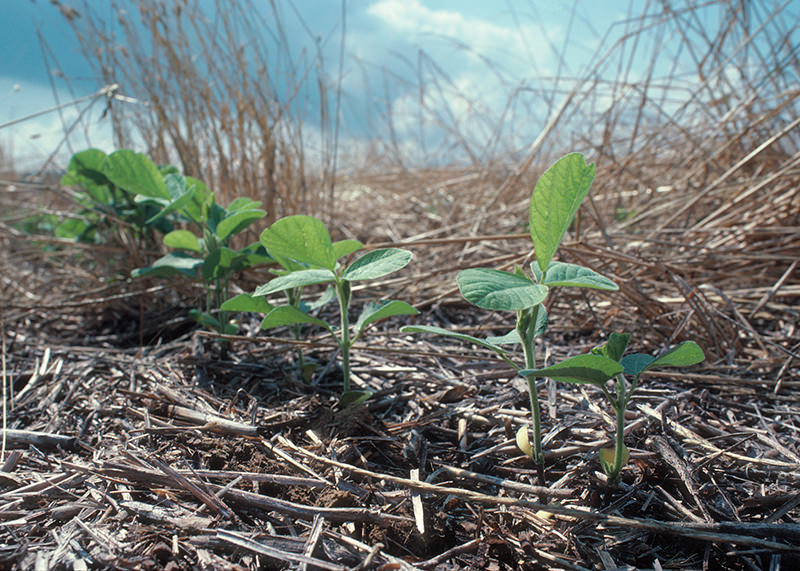
As someone who’s worked on farms all over the world, you’d think I would have some experience with an organic no-till farming system. I actually have none, and that’s always bugged me. I read about no-till, and think it sounds great for land and energy conservation, but to actually coach someone through how to do it, I’m useless. When the Organic Association of Kentucky announced the topic lineup for its conference this year and there were two no-till sessions with Rodale Institute director Jeff Moyer, I thought I’d attend the first organic no-till session and then move on to a concurrent livestock session during the second. When Moyer’s first no-till session ended, I stayed in my seat—I needed to know more.
If you’re like me, wanting to know more about organic no-till farming and wondering if it’s something you want to try on your own small farm, check out the pros and cons of organic no-till.
Pro 1: You’ll strengthen your cover-crop game in a big way.
Without tillage to do away with weeds, cover crops become a primary tool in the weed battle.
“When no-till doesn’t work, it’s usually because the farmer screwed up planting cover crops. This is the most important crop you’re going to plant,” Moyer says.
You’ll learn to choose the right variety and plant at the right density to cover the ground and keep weed seeds from germinating. “If I can see the ground and the ground can see the sun, weeds are going to germinate,” he continues.
Having this built-in mulch not only suppresses weeds but also provides shade to the soil and provides habitat to beneficial insects, birds and wildlife year-round.
Pro 2: You’ll save money and time by running machinery less often.
The basic steps to no-till cropping are:
- Plant the cover crop. (Granted, this initial planting might involve tillage.)
- Knock down the cover crop with a crimper-roller at the same time you plant vegetable- or row-crop seeds or transplants.
- Harvest the vegetable or row crop.
- Plant the next cover crop.
There’s no cultivation or seed-bed preparation involved, so you don’t have to pass through the field with a tractor or with hand equipment.
According to the Conservation Technology Information Center, no-till saves an average of 3½ gallons of fuel and $5 worth of equipment maintenance per acre of land per year.
In addition to money and time, you’ll save your land from soil compaction and erosion, too.
Pro 3: Your crops will be cleaner.
Moyer points out that pumpkins, for example, grown in a no-till system on a mulch of cover-crop residue don’t get muddy, so they don’t need to be scrubbed before going to market. Clean pumpkins are more attractive to the U-pick crowd, too.
Pro 4: Your soil microbial population will spike.
It’s not just the numbers of microbes in the soil that will do really well but also the diversity of the microbes. Think about it: You’re creating an environment that they will thrive in, and then you’re not coming through every few months and beating it to hell with a tiller. You’re allowing the establishment of a healthy microbial community underground, fostering that community and letting it regulate itself. The microscopic water and nutrient pathways that they’ve carved throughout the soil will remain intact, the nutrients and carbon being held in the soil will remain in the soil, and the water-holding capacity of the soil will be improved.

Con 1: You don’t get the benefits that bare soil offers.
It’s not good to leave soil naked for long—this is a basic truth that you learned about soil erosion in elementary-school science. But bare soil does warm up faster in the spring than soil that’s covered with a thick bed of crop residue. Also, soil amendments applied directly to bare soil can be more effective, and broadcast seeding is certainly more effective on bare soil.
Con 2: You’ll spend money on cover-crop seed.
See “Pro 1,” above. You are spending money on seed, but you are planting a mulch. You might not see the financial benefit in the first year, but as you practice your cover cropping and perfect your varieties, density and timing, the cost of the seed will pay off.
Con 3: You’ll need to change up your equipment.
A mower or roller-crimper and a no-till drill with a coulter that can cut through cover-crop residue are required for no-till farming. Some varieties of cover crop can be mowed at the right stage of growth to kill the cover crop; other varieties of cover crop need to be crimped and rolled. (Rodale Institute has a video explaining this process.) Either way, you’ll need a no-till transplanter and seed drill to cut through the residue and get your transplants or seeds into the soil. You can modify many pieces of equipment, build your own or find used, if you’re not ready to make a major investment.
Con 4: You’ll be forced to map out your farm plan for five years and more.
Who are we kidding? This is not a negative. This is a positive—a time-consuming, hand-wringing positive.
“If you can’t tell me what’s going to be in each field five years from now, you’re not ready,” Moyer says.
Get out your crop-rotation plan and look at whether no-till is a growing method that you want to employ on your farm. The cover-crop practice, time and resource savings, microbiome strength, and clean crops sound great, but the equipment modifications, cost of cover-crop seed, loss of your soil-amendment crutch and major farm-planning effort should make you consider no till’s pros and cons carefully.




